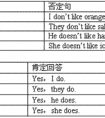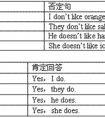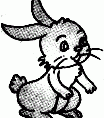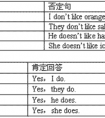按要求改写句子。1. She is good at Chinese. (划线提问)she?2. I'm Ben. (同义句)is Ben.3. I live at 20 Purple Street. (否定句) I at 20 Purple Street.4. I-四年级英语
题文
| 按要求改写句子。 |
| 1. She is good at Chinese. (划线提问) she ? 2. I'm Ben. (同义句) is Ben. 3. I live at 20 Purple Street. (否定句) I at 20 Purple Street. 4. I come from Britain. (一般疑问句) you from Britain ? 5. I'm in Class Two. (划线提问) in? 6. Her name is Cathy. (划线提问) ___ ___? 7. I'm in Grade Four. (一般疑问句) Grade Four? 8. My name's Peter. (否定句) My Peter. |
答案
| 1. What is good at 2. My name 3. don't live 4. Do come 5. What class are you 6. What is her name 7. Are you in 8. name is not |
据专家权威分析,试题“按要求改写句子。1. She is good at Chinese. (划线提问)she?..”主要考查你对 一般疑问句,单数名词,物主代词,疑问代词,形容词,介词 等考点的理解。关于这些考点的“档案”如下:
一般疑问句单数名词物主代词疑问代词形容词介词
考点名称:一般疑问句
- 一般疑问句:
是疑问句的一种。它是以be动词,have或助动词、情态动词开头,用yes(是)或no(否)来回答的句子。
其结构是:系动词be/助动词/情态动词+主语+其他成分
一般疑问句的肯定形式为:
助动词+主语(+实义动词)。肯定答语用“yes+可定结构”。
一般疑问句的否定形式为:
助动词构成的缩写否定词+主语(+实义动词)。否定答语用“no+否定结构”。
例:
— Do you like this story-book? 你喜欢这本故事书吗?
— Yes, I do. 喜欢。/ No, I don’t. 不喜欢。
— Is he a student? 他是一名学生吗?
— Yes, he is. 是,他是。/ No, he isn’t. 不,他不是。 一般疑问句的改写:
一、含有be动词的一般疑问句,通常把be动词调到句首。例如:
陈述句:They are in the swimming pool.
一般疑问句:Are they in the swimming pool?
注意:一般疑问句句末要用“?”。
二、含有情态动词的一般疑问句(can, may...),把情态动词调到句首。例如:
陈述句:He can drive a car.
一般疑问句: Can he drive a car?
三、含有have的一般疑问句,have译为“有”。一般疑问句式有两种形式:
1.把have/has调到句首。例如:
陈述句:Tommy has a computer.
一般疑问句:Has Tommy/he a computer?
2.加助动词do/does,第三人称单数用does,其他人称用do。其句型为:Do/Does + 主语 + have...?
例如上句可变为: Does Tommy have a computer?四、一般动词的一般疑问句,也要借助助动词do/does,第三人称单数用does,其余人称用do。
其句型为:Do/Does + 主语 + 动词原形+其它?
陈述句:Amy speaks English.
一般疑问句:Does Amy speak English?一般疑问句的回答:
首先要有人称的改变。当主语为名词时,在答语中要改成其相应的代词。
另外,答语有两种,肯定的回答(用yes)和否定的回答(用no),否定式常用缩写形式。
现在还是让我们分句型一一说明。一、一般疑问句含be动词时,用be动词回答,句末用句号。例如:
-Is Mary your sister?
-Yes, she is. / No, she isn’t.(缩写)二、一般疑问句含有情态动词(can, may, should等)时,用情态动词回答。例如:
-May I come in?
-Yes, you may. / No, you can’t.三、一般疑问句含有have(译为“有”)时,有两种回答方式。
1.直接用have/has回答。
例如:
-Have they any pictures?
-Yes, they have. / No, they haven’t.
2.用助动词do/does回答。
例如:
-Does Millie smoke?
-Yes, she does. / No, she doesn’t.四、一般动词的一般疑问句回答时也用助动词。
例如:
-Do the workers live in London?
-Yes, they do. / No, they don’t.
考点名称:单数名词
单数名词:
主要用来表示“一个”东西的概念。两个及其以上就应用复数名词来描述。
例如单数可数名词:man,river,book,glass,desk,cup,road,car,eye,foot,tree,bird,girl,boy英语上名词按可数与否可分为可数名词和不可数名词。
可数名词按数目又可分为单数名词和复数名词两类。
注意:不可数名词没有复数形式,如water(水)。
考点名称:物主代词
- 物主代词:
表示所有关系的代词叫做物主代词,也叫人称代词的所有格。物主代词分为名词性物主代词和形容词性物主代词两种。其中,形容词性物主代词后面需加名词;
名词性物主代词可直接作名词用,后面无需再加名词。





![____ it got four wheels?[ ]A. Have B. There C. Has-五年级英语](http://www.00-edu.com/d/file/ks/4/1/65/2019-08-31/small2ca0aeba76320ba6f81e40fe83a0e8111567199443.png)
